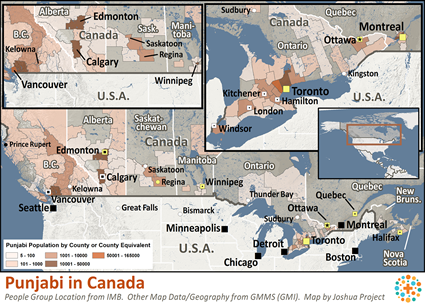A vast majority of the Punjabi live in India and Pakistan; however, large Punjabi communities can also be found in nearly thirty other countries. While the living conditions of the Punjabi differ greatly from country to country, they have retained much of their traditional culture and lifestyle.
The name "Punjabi" is used to describe both those who speak Punjabi, and those who inhabit the Punjab region in India and Pakistan. Punjabi is an Indo-European language that is divided into six main dialects. It is primarily spoken in the major regions of India and Pakistan.
Punjabis are also divided by three major world religions. Muslim Punjabis are largely in Pakistan. Hindus and Sikhs are mainly in India. The Sikh population is very prominent in Canada.
Though there were some Sikhs in Canada before the 1960s, that was the decade when immigration restrictions for South Asians began to relax in that country. Since that time Punjabis have become one of Canada's most important group of immigrants.
Punjabi immigrants have taken on a variety of occupations. Many of the Sikhs, who are characterized by their neatly wound turbans, have excelled as mechanics, construction workers, and business professionals. Other Punjabi have found work in retail and trade, particularly through small family businesses. They are also instrumental in helping Canada with her agricultural needs.
Marriage is highly desired among all Punjabi, whether Muslim, Hindu or Sikh. Traditionally, residences were patrilocal, which means that young couples lived in the husband's village near his parents. However, in most Diaspora Punjabi communities, this does not occur. Newly-married couples set up their homes wherever they choose. Marriages can still be arranged by parents, but this is rarely done without extensive discussions.
Sikhs run into some culture shock in Canada. One of their beliefs is that they must be ready to defend the innocent, so they carry a ceremonial kirpan, a dagger. This does not go over well in many situations. Sikh Punjabis are drawn to police work where the head gear does not work with the mandatory turban.
The Diaspora Punjabi reflect the three major religions of their homeland: Hinduism, Islam and Sikhism. Most of the Diaspora Punjabi speakers are Sikhs, including those in Canada.
Sikhism is a monotheistic religion that was founded in northern India during the sixteenth century. Its teachings have combined the elements of both Hinduism and Islam in an attempt to find one god who transcends all religious distinctions.
There have been minor breakthroughs among Punjabi Sikhs both in India and Canada. It's possible that Sikh background believers can take the gospel to others in Canada.
There is a great need for more church planting teams to begin focusing on the Punjabi. Their search for 'one god who transcends all religions' can provide the open door to share Jesus - the one true God and Savior - with them.
Ask God to give wisdom to missions agencies focusing on the Sikh Punjabis in Canada.
Pray that the Lord of the harvest will thrust forth loving laborers to work among the Punjabis.
Ask God to encourage Punjabi Christ followers to disciple others to make even more disciples.
Ask the Holy Spirit to soften their hearts towards the savior, Jesus Christ.
Ask the Lord to raise up strong local churches among the Punjabis.
Scripture Prayers for the Punjabi in Canada.
https://en.wikipedia.org/wiki/Sikhism_in_Canada
https://www.thecanadianencyclopedia.ca/en/article/sikhism
| Profile Source: Joshua Project |



























